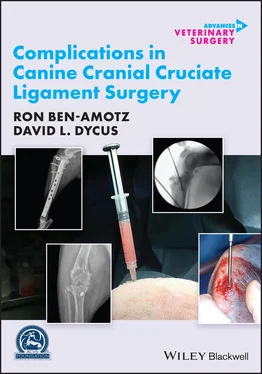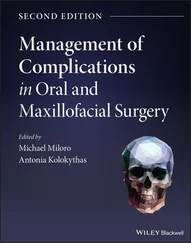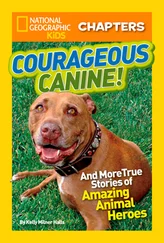8 Chapter 16Table 16.1 Clinical and radiographic changes in cats with cranial cruciate li...Table 16.2 Tibial plateau angle (TPA) measurements in the cat.Table 16.3 Tips for extracapsular stabilization surgery for CCL rupture in th...Table 16.4 Complications following extracapsular stabilization in the cat, wi...Table 16.5 Tips for tibial plateau leveling osteotomy (TPLO) surgery for CCL ...Table 16.6 Tips for tibial tuberosity advancement (TTA) surgery for CCL ruptu...
1 Chapter 1 Figure 1.1 An immediate postoperative radiograph of stifle stabilization via... Figure 1.2 Radiograph of a 12‐week‐old dog that suffered a traumatic CCL inj... Figure 1.3 Representation of offloading the left pelvic limb at a stance. Th... Figure 1.4 A patient with instability of the left pelvic limb secondary to a... Figure 1.5 An example of a positive sit test in a patient with a right CCL t... Figure 1.6 An example of a square sit in a patient with no CCL pathology. No... Figure 1.7 Demonstration of the cranial drawer test. One hand is placed on t... Figure 1.8 Demonstration of the tibial compression test. One hand is placed ... Figure 1.9 A lateral radiograph documenting appropriate positioning of the s... Figure 1.10 A cranial‐caudal radiograph documenting appropriate position of ... Figure 1.11 Evidence of joint effusion in the stifle of a patient with CCL p... Figure 1.12 Evidence of degenerative changes in the stifle of a patient with...
2 Chapter 2 Figure 2.1 (a)Mild bacterial dermatitis with pustules and plaques. (b)Mild ... Figure 2.2 Hanging leg technique for limb suspension. (a)A piece of 2 in. t... Figure 2.3 Skin preparation steps. Note the assistant is wearing nonsterile ... Figure 2.4 (a)Chlorhexidine gluconate 4% soap solution. (b)Povidone‐iodine... Figure 2.5 (a)Avagard™ chlorhexidine gluconate 1% + ethyl alcohol 61%. (b)... Figure 2.6 Example of a surgical safety checklist, based on the World Health... Figure 2.7 Following final skin preparation in the OR with the limb suspende...
3 Chapter 3 Figure 3.1 For the Levine technique, the swab is contacting the wound bed on... Figure 3.2 (a)A craniocaudal (CC) view of a TPLO with periosteal reaction e... Figure 3.3 A dehisced lateral stifle incision with local erythema and purule... Figure 3.4 Scanning electron microscopy image of a biofilm. Figure 3.5 In this craniocaudal view of the antebrachium, two discontinuous ... Figure 3.6 (a)Exposed TPLO plate. (b)Screw removed. When removing screws t...
4 Chapter 4 Figure 4.1 Radiograph of a stifle joint with a DDFT allograft secured by use... Figure 4.2 Intraoperative photograph of a DDFT allograft repair using the Tr...Figure 4.3 Harvesting a DDFT allograft for use in an IA repair. Damaging ten...Figure 4.4 A DDFT allograft after harvest. Due to the inconsistent circumfer...Figure 4.5 Placement of bone tunnels can be aided by use of an aiming guide....Figure 4.6 Bone tunnels are often difficult to visualize on postoperative ra...Figure 4.7 A challenge of IA repair can be passing the graft through the bon...Figure 4.8 (a–c)A 6.8‐year‐old male neutered Labrador Retriever (33 k...Figure 4.9 A 4.5‐year‐old male neutered Boxer (35 kg) presented for second‐l...Figure 4.10 This radiograph was taken while the patient was weight bearing. ...Figure 4.11 (a)A 4.5‐year‐old female spayed Labrador Retriever (33 kg) pres...Figure 4.12 (a)A 2.5‐year‐old male neutered mixed‐breed dog (23 kg) present...Figure 4.13 The arthroscopy image shows the remnants of the graft (white arr...Figure 4.14 (a)Preoperative and (b)12‐month follow‐up radiographs from a d...Figure 4.15 A 6.5‐year‐old female spayed Labrador presented with an acute no...
5 Chapter 5Figure 5.1 Original case published on the Slocum Enterprises website in Augu...Figure 5.2 Variation of the slope after partial epiphysiodesis in dogs from ...Figure 5.3 Decreasing of the TPA of all dogs after partial epiphysiodesis 30...Figure 5.4 Mediolateral radiographic view of the tibia. Both the tibial and ...Figure 5.5 Partial CCL rupture in the left stifle of a 5.5‐month‐old Maremma...Figure 5.6 Caudocranial radiographic view of the tibia. Mechanical medial pr...Figure 5.7 Femoral avulsion of the origin of the CCL in a 6‐month‐old Labrad...Figure 5.8 Tibial avulsion of the insertion of the CCL in (a)a 5‐month‐old ...Figure 5.9 Complete rupture of the CCL in the right stifle of a 4.5‐month‐ol...Figure 5.10 Femoral avulsion of the caudal cruciate ligament in the left sti...Figure 5.11 A medial femoral condylar osteochondrosis lesion in a 7‐month‐ol...Figure 5.12 Seven‐month‐old Great Dane with avulsion of the origin of the lo...Figure 5.13 (a–d)Intraoperative pictures of an acute femoral avulsion...Figure 5.14 Radiographic views of the case shown in Figure 5.13. (a)Preoper...Figure 5.15 Tibial avulsion of the insertion of the CCL in a 5.5‐month‐old A...Figure 5.16 Insertion of guide wire: a stab incision is made medial or later...Figure 5.17 Correct screw position at the most proximal part of the tibial p...Figure 5.18 The position of the K‐wire is confirmed with fluoroscopy, in bot...Figure 5.19 (a–e)A cancellous screw of a planned length is then inser...Figure 5.20 Cannulated screw used over a guide wire. Predrilling and tapping...Figure 5.21 Insertion of a cannulated screw over a guide wire is performed o...Figure 5.22 (a)Postoperative radiographs (medio‐lateral and caudo‐cranial) ...Figure 5.23 (a)Intraoperative image of a 5‐month‐old Golden Retriever with ...Figure 5.24 (a)Immediate postoperative screw position for PTE. Note the lat...Figure 5.25 Lateral radiographic projection of a 5‐month‐old Golden Retrieve...Figure 5.26 Cranio‐caudal radiographic views measuring the mMPTA of the same...Figure 5.27 A minimal medial offset of a screw (frontal plane) resulted in 8...Figure 5.28 A marked medial offset of a screw (frontal plane) resulted in 9°...Figure 5.29 Moderate lateral offset of a screw (frontal plane) resulted in 8...Figure 5.30 Centrally positioned screw (frontal plane) resulted in no change...Figure 5.31 Right stifle: a malpositioned screw head can result in an insuff...Figure 5.32 Immediate postoperative radiograph showing a screw placed too de...Figure 5.33 An insufficient reduction of a TPA at 3 months postoperatively i...Figure 5.34 PTE performed in a 6‐month‐old Weimaraner resulted in an insuffi...Figure 5.35 PTE performed in a 6‐month‐old Newfoundland. At 6 months postope...Figure 5.36 PTE performed in a 6‐month‐old Labrador Retriever. At 6 months p...Figure 5.37 PTE performed in a 4.5‐month‐old Border Collie. At day 70, the T...Figure 5.38 PTE performed in a 5.5‐month‐old Labrador Retriever with a Salte...Figure 5.39 Excessive TPA necessitated the removal of the screw. A small inc...
6 Chapter 6Figure 6.1 Tensioning device being utilized Intra‐operatively to set a FCBT ...Figure 6.2 Second pair of gloves prepared for overgloving process prior to i...Figure 6.3 Arthrocentesis of a right stifle joint to detect the presence of ...Figure 6.4 (a)Explanted multifilament polyblend polyethylene implant with c...Figure 6.5 Therapeutic right stifle joint lavage in suspected septic arthrit...
7 Chapter 7Figure 7.1 (a)Preoperative lateral radiograph of a 4.3 kg Yorkie with TPA =...Figure 7.2 Bone anchor 3 years post placement in a 4.9 kg patient. (a)Later...Figure 7.3 Isometric points on femur and tibia.Figure 7.4 Femoral bone anchor failure. (a)Lateral view. (b)Caudal‐cranial...Figure 7.5 Path of LES enclosing femoral and tibial isometric points.Figure 7.6 (a)Properly crimped oval crimp tube. (b)Improperly crimped oval...Figure 7.7 LES failure with crimp displacement.
Читать дальше












